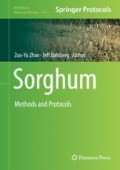Abstract
Sorghum is the fifth most important cereal grain crop after corn, wheat, rice, and pearl millet in the world. Conventional sorghum breeding relies on multiple generations of self-pollination to achieve the adequate levels of homozygosity for hybrid evaluation, which adds several years and great cost to the breeding process. As in maize, doubled haploid (DH) is the key technology to speed up the breeding process in sorghum. Through 3 years of efforts, two haploid inducer lines, SMHI01 and SMHI02, were discovered by screening 4000 germplasms worldwide. These two inducers have been evaluated in different growth environments and have shown to generate haploids at frequency of 1–2%. The putative haploids produced with these two inducers were evaluated and ploidy was confirmed cytologically and biochemically. The discovery of these inducer lines is the first step toward a revolutionary change in sorghum breeding.
Access this chapter
Tax calculation will be finalised at checkout
Purchases are for personal use only
References
Blakeslee AF, Belling J, Farnham ME, Bergner AD (1922) A haploid mutant in the jimson weed, Datura stramonium. Science 55:646–647
Chase SS (1949) Monoploid frequencies in a commercial double cross hybrid main and in its component single hybrids and inbred lines. Genetics 34:328–332
Chase SS (1952) Production of homozygous diploids of maize from monoploids. Agron J 44:263–267
Kasha KJ, Kao KN (1970) High frequency haploid production in barley (Hordeum vulgare L.). Nature 225:874–876
Guha S, Maheswari SC (1964) In vitro production of embryos from anthers of Datura. Nature 204:497
Forster BP, Haberle-Bors E, Kasha KJ, Touraev A (2007) The resurgence of haploids in higher plants. Trends Plant Sci 12:368–375
Snape J (1989) Doubled haploid breeding: theoretical basis and practical applications. In: Mujeeb-Kazi A, Sitch LA (eds) Review of advances in plant biotechnology. IRRI. International Maize and Wheat Improvement Center, Edo Mex, pp 19–30
Raina SK (2010) Doubled haploid breeding in cereals. In: Janick J (ed) Plant breeding reviews, vol 15. John Wiley & Sons, Oxford
Murovec J, Bohanec B (2011) Haploids and doubled haploids in plant breeding. In: Abdurakhmonov I (ed) Plant breeding, INTECH pp 87–106. WWW.intechopen.com
Liu W, Zheng MY, Polle EA, Konzak CF (2002) Highly efficient doubled-haploid production in wheat (Triticum aestivum L.) via induced microspore embryogenesis. Crop Sci 42:686–692
Melchinger AE, Longin CF, Utz HF, Reif JC (2005) Hybrid maize breeding with doubled haploid lines: quantitative genetic and selection theory for optimum allocation of resources. In: Proceedings of the forty first annual Illinois corn breeders’ school, Illinois, United States pp 8–21
Röber FK, Gordillo GA, Geiger HH (2005) In vivo haploid induction in maize- performance of new inducers and significance of doubled haploid lines in hybrid breeding. Maydica 50:275–283
Coe EH (1959) A line of maize with high haploid frequency. Am Nat 93:381–382
Pollacsek M (1992) Management of the ig gene for haploid induction in maize. Agronomie 12(3):247–251
Sopory S, Munshi M (1996) Anther culture. In: Mohan JM et al (eds) In vitro haploid production in higher plants, vol 1. Kluwer Academic Publishers, Dordrecht, pp 145–176
Nitsch C (1977) Culture of isolated microspores. In: Reinert J, YPS B (eds) Plant cell, tissue and organ culture. Springer, Berlin Heidelberg New York, pp 268–278
Geiger HH (2009) Doubled haploids. In: Bennetzen JL, Hake S (eds) Handbook of maize. Springer, New York, pp 641–657
Zheng MY, Weng Y, Liu W, Konzak CF (2002) The effect of ovary-conditioned medium on microspore embryogenesis in common wheat (Triticum aestivum L.). Plant Cell Rep 20:802–807
Forster BP, Thomas WTB (2010) Doubled haploids in genetics and plant breeding. In: Janick J (ed) Plant breeding reviews, vol 25. John Wiley & Sons, Oxford
Kunz C, Islam SMS, Berberat J, Peter SO, Buter B, Stamp P, Schmid JE (1999) Assessment and improvement of wheat microspore derived embryo induction and regeneration. J Plant Physiol 156:190–196
Chang MT, Coe EH (2009) Doubled haploids. In: Kriz AL, Larkins A (eds) Biotechnology in agriculture and forestry, vol 63. Springer, New York, pp 127–142
Geiger HH, Gordillo GA (2009) Doubled haploids in hybrid maize breeding. Maydica 54:485–499
Hansen NJP, Andersen SB (1996) In vitro chromosome doubling potential of colchicine, oryzalin, trifluralin and APM in Brassica napus microspore culture. Euphytica 88:159–164
Mathias R, Robbelen G (1991) Effective Diploidization of microspore-derived haploids of rape (Brassica napus L.) by in vitro colchicine treatment. Plant Breed 106(1):82–84
Wan Y, Petilino JF, Widholm JM (1989) Efficient production of doubled haploid plants through colchicine treatment of anther-derived maize callus. Theor Appl Genet 77(6):889–892
Acknowledgments
This study is a collaborative research project between DowDuPont™ and the United Sorghum Checkoff Program. All research was conducted by DowDuPont™ scientists and the research funding was provided by the United Sorghum Checkoff Program.
Author information
Authors and Affiliations
Corresponding author
Editor information
Editors and Affiliations
Rights and permissions
Copyright information
© 2019 Springer Science+Business Media, LLC, part of Springer Nature
About this protocol
Cite this protocol
Hussain, T., Franks, C. (2019). Discovery of Sorghum Haploid Induction System. In: Zhao, ZY., Dahlberg, J. (eds) Sorghum. Methods in Molecular Biology, vol 1931. Humana Press, New York, NY. https://doi.org/10.1007/978-1-4939-9039-9_4
Download citation
DOI: https://doi.org/10.1007/978-1-4939-9039-9_4
Published:
Publisher Name: Humana Press, New York, NY
Print ISBN: 978-1-4939-9038-2
Online ISBN: 978-1-4939-9039-9
eBook Packages: Springer Protocols

